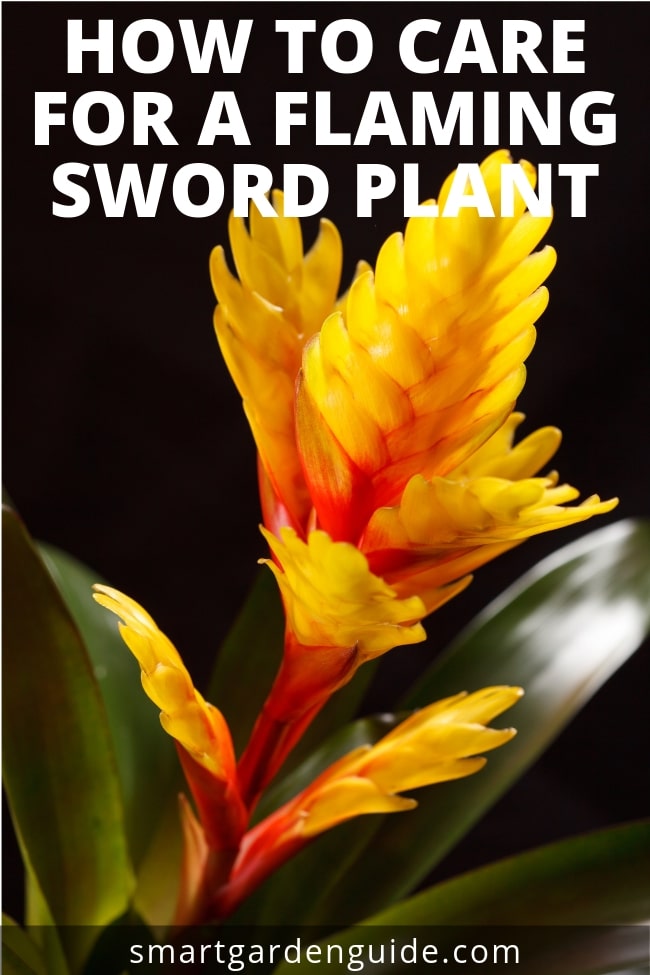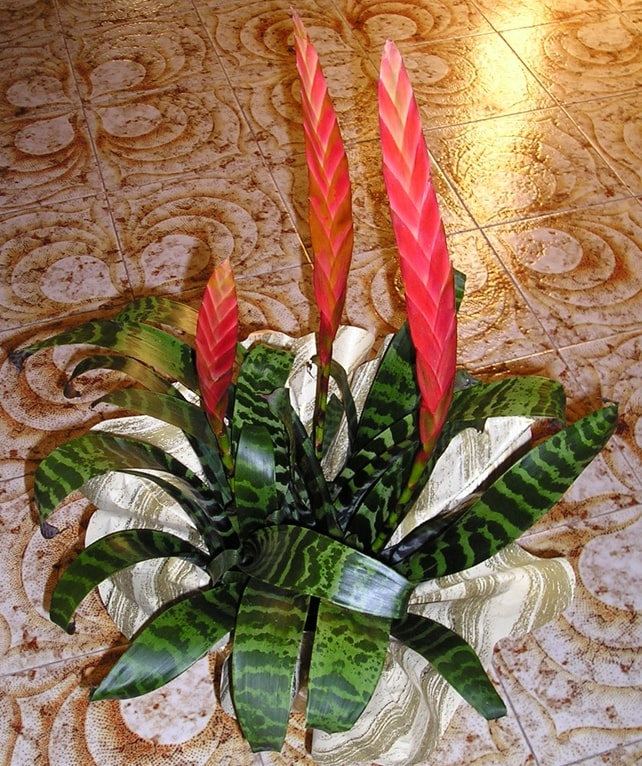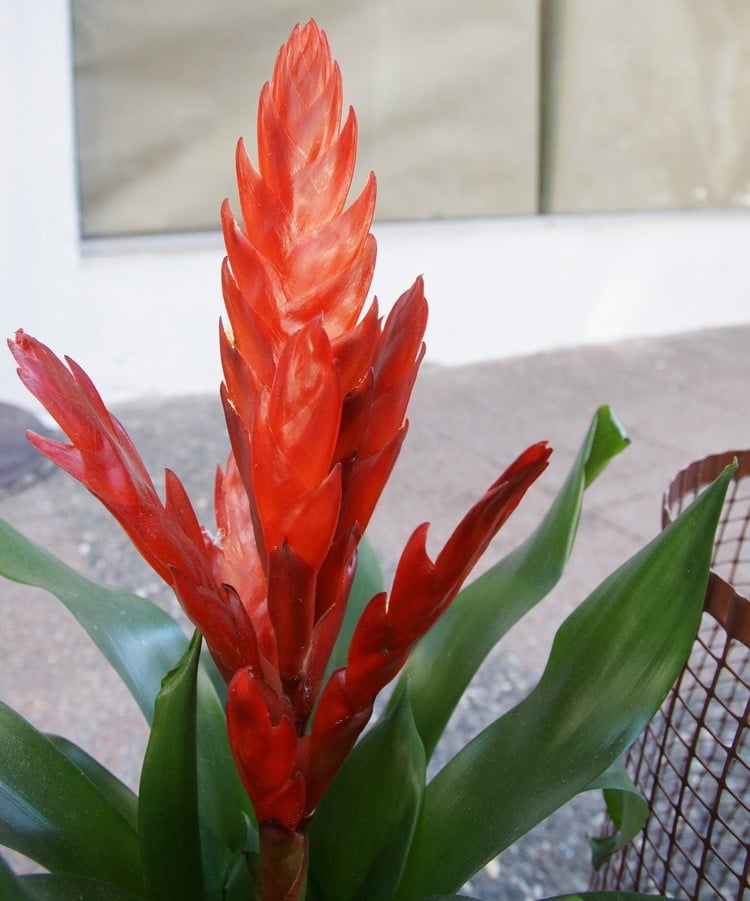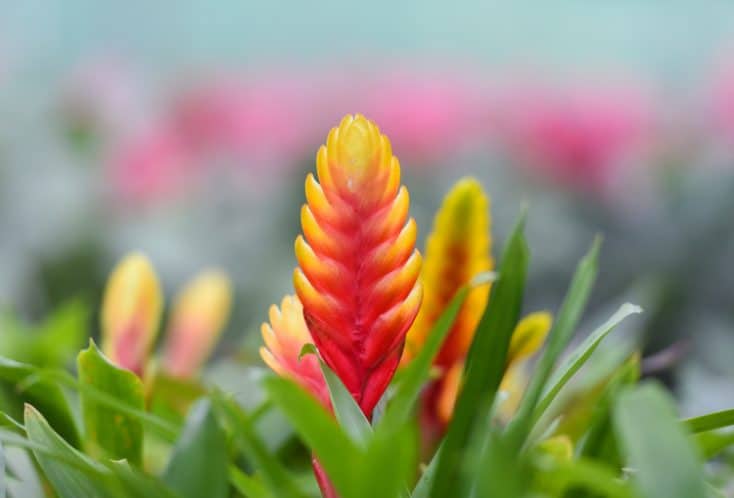With a name like “flaming sword plant,” you expect something fabulous. Well, Vriesea splendens definitely lives up to its name, with its striking banded foliage and its flamboyant floral display.
The flaming sword plant belongs to the genus Vriesea (pronounced vree’ see ah), a group of bromeliads from South and Central America that make great houseplants – not only because they liven things up with their exotic splendor, but also because they are so easy to take care of.
First, a quick summary of vriesea splendens (flaming sword plant) care.
How to care for a vriesea plant – Pot in well-draining bromeliad mix and place in bright filtered sunlight. Unlike other plants, you need to provide water to the plant’s central reservoir, keeping the potting mixture just barely moist, and mist the foliage regularly. Provide comfortably warm indoor temperatures and high humidity and airflow.
- Soil: Lightweight well-draining bromeliad or orchid potting mixture.
- Container: Small pot with drainage holes; flaming sword plants don’t typically need repotting.
- Light: Tolerates different lighting, but bright filtered sunlight is needed for blooming.
- Temperature: Average room temperatures of above 65 °F (18 °C).
- Humidity: High humidity to provide moisture to the foliage balanced with good airflow.
- Watering: Water by filling the central reservoir. Keep the growing medium slightly moist, and mist the foliage several times per week. Always use pure lukewarm water.
- Fertilizing:Very little fertilizer needed; apply foliar fertilizer once or twice a year.
- Propagation: Offsets can be propagated easily.
Vriesea care is a little different from other indoor potted plant care, since most vrieseas are epiphytes, which grow on trees rather than in soil. But once you get to know these charismatic plants, you’ll quickly understand why they are so beloved by casual indoor gardeners and hardcore bromeliad collectors alike!
This article now will go over each aspect of vriesea care in more detail, and cover some of the common questions and problems that you might have.

Introduction To The Vriesea Flaming Sword Plant
The key to growing the vriesea flaming sword plant indoors is to recognize that it is an epiphytic bromeliad, so it has certain features that are different from most other plants.
First of all, these bromeliads don’t have much in the way of roots. And what roots they do have are more adapted to gripping and anchoring the plant to the surface of trees than to absorbing water and nutrients, like most root systems.
So instead of drawing the elements they need from the soil, these plants are able to absorb them from the air through tiny scales on their leaves known as “trichomes.”
In addition to being very efficient at absorbing water and nutrients, trichomes are also responsible for the attractive foliage patterns on many vriesea varieties, with the flaming sword plant’s long arching leaves being notable for their deep purple crossbanding.
Bromeliad leaves typically grow in a spiral formation called a “rosette,” and by tightly overlapping at the base, vriesea leaves form a central reservoir, known as a “tank,”that collects and stores water as well as organic debris. The tank provides the plant with much of the moisture and nutrients it needs.
So you have this central reservoir or tank, and out of it, the flaming sword plant’s flower spike can rise up to three feet (about 90 centimeters) high, showcasing the magnificent sword-shaped inflorescence that gives the plant its name.
But what appear to be bright red overlapping flower petals aren’t what they seem. Those aren’t flowers; they’re bracts – modified leaves at the base of the small, unremarkable yellow structure that is the actual flower. These very long lasting, brightly colored bracts attract pollinators to the plant.
Now, you should know that these and most other bromeliads only blossom once before slowly withering and dying away. But don’t panic! You can grow new plants from the offshoots that appear as the plant declines.
It takes three to five years for vrieseas to bloom, and the flaming sword plant inflorescence lasts for many months. Even when not in bloom, their handsome foliage still makes vrieseas very appealing houseplants.
What Soil Do Vrieseas Need?
Because vriesea roots are adapted for the constant cycles of moisture followed by periods of dryness that occur in their tropical rainforest habitats, they are highly susceptible to rotting, so you don’t want to use a potting mixture that holds a lot of moisture.
And since these roots are accustomed to being exposed to the air in their natural setting, they also need plenty of airflow. Therefore, the growing medium for vrieseas should consist of materials that are lightweight, quick to dry out, and provide plenty of aeration. Use a commercial bromeliad or orchid potting mixture, or make your own mixture with peat moss, coco coir, or pine bark blended with a little perlite.
What Kind Of Container Should I Use For A Flaming Sword Plant?
Since they have such a meager root system, you want to provide the smallest size pot that will support the fully grown vriesea, as this will help ensure that the potting mixture at the center of the pot doesn’t retain too much moisture.
A 5-inch (13-centimeter)pot is a good size for a flaming sword plant, which grows to about a foot (30 centimeters) wide. These plants usually don’t need to be repotted.
Consider using a clay or terracotta pot for any type of vriesea, so you can keep the roots happy with a smaller size pot that has the weight to hold the plant steady when it grows larger.
These types of pots are also advantageous over plastic because they allow the potting mixture dry out faster. Regardless of what material you choose, it’s essential for the pot to have drainage holes.
When potting a vriesea, place some gravel at the bottom of the pot before filling it with potting mixture to ensure excellent drainage, and make sure the plant is held firm in the growing medium without packing it too tightly.

Vriesea Light Requirements
In general, vrieseas are quite tolerant of different lighting conditions, but they will only bloom if they have bright filtered sunlight. To get more specific, vrieseas with softer green leaves need less light, while varieties with sturdier patterned foliage prefer stronger light – and in fact, brighter light exposure will often enhance the color and patterns.
So the flaming sword plant will do well near a window with eastern or western exposure, as long as they are not getting intense, direct sunlight, which can cause bleach spots or sunburn damage to the leaves.
What Temperatures Do Vriesea Flaming Sword Plants Need?
Happily, flaming sword plants and other vrieseas do very well in temperatures that are typical of indoor environments – which is just one of the reasons why these bromeliads make great houseplants.
An average room temperature of above 65 F (18 C) is comfortable for us humans as well as for the flaming sword plant and its vriesea cousins.
How Much Humidity Do Vrieseas Need?
As for humidity for vrieseas, typical household levels will not suffice, so you’ll have to take measures to provide at least 50 percent relative humidity for your flaming sword plant.
High humidity is essential to these plants because they absorb most of their moisture through the trichomes on their foliage rather than from their roots.
Using a humidifier is just one method for raising the humidity level for your plant. Another technique is to use a pebble tray. This is simply a shallow plate or tray filled with pebbles and water upon which you set your potted plant. The pebbles hold the pot just above the water level so that rather than being absorbed into the potting mixture, the water evaporates, providing a miniature humid microclimate for the plant.
Or, you could also increase the local humidity for the plant by double potting it.You just place the small bromeliad pot inside a slightly larger pot and then stuff sphagnum moss between the two, which you keep moistened.
Also, grouping plants together – especially those that prefer higher humidity – will allow them to mutually benefit from their own natural transpiration. And you can always place the plant in the bathroom while showering to treat the foliage to a nice dose of warm moisture.
It’s super important, when you have high humidity, that you also have sufficient air circulation to prevent harmful bacterial and fungal growth. So make sure the area the plant is in has good ventilation and airflow, which may necessitate a gentle-blowing fan nearby but not blowing directly on the plant.
Just make sure your vriesea is not in a location where it will be affected by a cold draft, as this will cause shock to these tropical plants. Also, do not place the plant close to a fireplace or other heat source that contributes to indoor dryness.
How Do You Water A Vriesea Flaming Sword Plant?
As you’ve undoubtedly noticed from the care summary and plant descriptions above, you don’t water a flaming sword plant the same way as you water other houseplants.
There are basically three components to watering these and other vriesea houseplants: the central rosette tank, the potting mixture, and the foliage. The idea is to provide moisture to different parts of the plant without overwatering, which will quickly lead to rot and disease.
You have to admit, the central reservoir is a pretty amazing adaptation developed by “tank bromeliads,” as they’re sometimes called, for collecting water and nutrient sources from the environment around them in place of drawing these elements from the soil through their roots.
It seems so perfect! Too perfect, perhaps, as the tendency is to just fill this little built-in reservoir and keep it filled. But this can lead to stagnation and rotting.To avoid this, flush out the plant’s tank once a week by filling it with fresh water and then dumping it out before refilling to water the plant.
Alternatively, some vriesea growers prefer to pour water into the tank to a maximum of about one quarter full and allow it to dry out between watering. If you use this method, you should still flush the tank every month or so to prevent salt buildup on the surface of the leaves.
For vrieseas grown as indoor houseplants, you should also dampen the potting mixture. It should be kept just barely moist by watering when it appears dry at the top.
Then there’s the foliage, which is covered with those specialized trichome scales that absorb water and nutrients. Mist these leaves twice a week or so to help them stay healthy and vibrant.
Last but definitely not least is the issue of water quality. Bromeliads are very sensitive to the mineral salts often found in water sources, so if you have hard water in your home, be sure to use purified or distilled water for your vriesea, instead. Also, make sure the water is lukewarm to avoid shocking the plant.
Do Flaming Sword Plants Need Fertilizer?
While flaming sword plants and their cousins grown outdoors may not need fertilizing, vrieseas grown as indoor houseplants lack that rich environment of plant and insect debris and will benefit from occasional feeding.
Fertilizing the plant will help it grow larger and mature faster – which, if you think about it, really only ends up shortening the lifespan of the plant.
It’s best to spray a very gentle foliar fertilizer directly onto the leaves. You can also add a small amount of diluted liquid fertilizer to the rosette tank, although you risk chemical burn from the salts if you use too much. Just be sure to limit feedings to once or twice a year in spring and summer only.
How Do You Propagate A Flaming Sword Plant?
As previously mentioned, vrieseas only bloom once during their lifecycles, which is typical of most bromeliads. When they are finished blooming, which lasts for months on end, these plants put all their energy into self-replication, producing plantlets known as “offshoots” or “pups.”
These little pups appear in the center of vrieseas and feed off the mother plant until they’ve developed enough to produce roots and survive on their own. You can wait until the mother plant has started to turn brown and die, or cut them away after they have grown at least 5-6 inches (13-15 centimeters) tall.
To harvest the pups, use a clean, sharp knife to cut away the flower spike and foliage, making sure there are roots attached. Plant them in lightweight potting mixture. Since they tend to be top-heavy, you may need to use stakes to hold them up until their roots have matured enough to anchor the plant.
Vriesea Flaming Sword Plant FAQ

This is the part where we answer questions about flaming sword plants, and vrieseas in general, that have not been addressed in the previous sections. If you have more questions, feel free to ask in the comment section!
How Do You Get A Flaming Sword Plant To Bloom?
Greenhouses use ethelene gas to stimulate blooms once a pup has grown to at least three-fourths the size of the parent plant, and you can do the same by placing a piece of banana or apple peel near the base of your plant. Given plenty of bright, filtered sunlight and a rise in temperature to about 75 F (24 C), blooming should occur in six to ten weeks.
What Pests Are Vrieseas Susceptible To?
Vrieseas tend to be pretty pest-free, although like most houseplants, they are susceptible to mealy bugs and scale, which you should simply wipe away rather than using a pesticide or oil spray that will suffocate the plant. The best way to prevent bugs and fungus is to provide good ventilation and avoid over-watering.
Are Vrieseas Poisonous For Pets?
Bromeliads including the flaming sword plant and other vrieseas are considered non-toxic to both dogs and cats.
Can I Grow A Flaming Sword Plant Under Artificial Light?
Yes, you can use fluorescent lighting, as long as you provide at least 250 foot-candles of full-spectrum light for a minimum of 12-14 hours a day.
What Are Some Other Types Of Vriesea That Are Easy Care Houseplants?
- Vriesea carinata is a small, green-leaved variety that produces lovely red bracts resembling a lobster claw
- Vriesea fosterianais valued for its patterned foliage that’s similar to the flaming sword plant but with cream-colored crossbanding against a background that’s more green on the lower, more mature leaves and has a maroon tinge on the younger upper leaves
- Vriesea giganteais another foliage plant that has wide leaves with cream and grayish green variegation and an interesting matte finish

